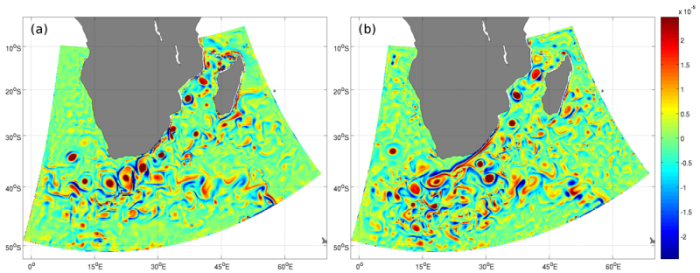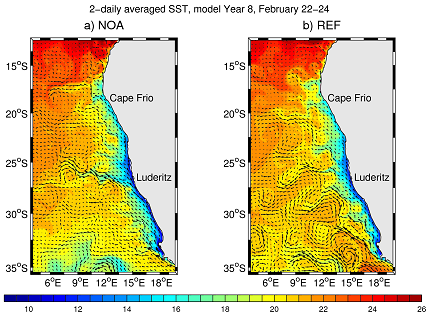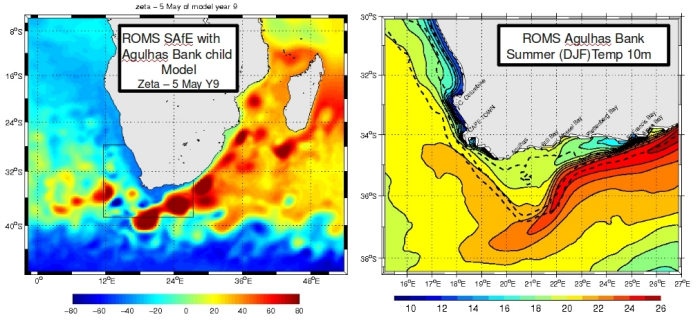Post-doc QualificationsBjorn BackebergPost-doctoral fellow at the Nansen-Tutu Centre for Marine Environmental Research, University of Cape Town Research interest:For my PhD dissertation I implemented the Hybrid Coordinate Ocean Model (HYCOM) in the greater Agulhas Current system. The main objective of this work was to develop HYCOM for mesoscale modelling of the region. This included performing hindcast simulation experiments and validating the model fields against satellite remote sensing and in-situ data, and implementing and testing new model developments. The major findings are both methodological and oceanographic in nature. We were able to show that implementing an advanced numerical scheme for momentum advection (4thorder quadratic upstream interpolation) significantly improved the dynamics of the model simulation. Studying the output from this model simulation we showed that eddy formation in the Mozambique Channel is related to the South Equatorial Current north of Madagascar, that these form 5-6 times per year, and frequently interact with the Agulhas Current further south, causing strong poleward volume fluxes that then influence the flux of warm, salty water into the South Atlantic Ocean, which is thought to play a critical role in maintaining the Atlantic meridional overturning circulation.
Presently, I am involved in further developing HYCOM for mesoscale modelling of the Agulhas Current, which is work being done in collaboration with the Mohn-Sverdrup Centre for Global Ocean Studies and Operational Oceanography at the Nansen Environmental and Remote Sensing Centre in Bergen, Norway. Affiliations:
Contact:
Jennifer VeitchPost-doctoral fellow, UCT/Nansen-Tutu Centre Research interest:My PhD research made use of the Regional Ocean Modelling System (ROMS) to systematically investigate equilibrium conditions and seasonal variations of the Benguela system, including both the large-scale flow regime as well as the coastal upwelling regime. The effect of topography on coastal upwelling was investigated by smoothing alongshore coastline and topography variations in the model, which showed that in all of the seven major upwelling cells, upwelling is enhanced on the downstream side of capes. Mesoscale variability of the Benguela system is obviously dominated by Agulhas influx and instabilities associated with it. In an attempt at quantifying this, I conducted a numerical modelling experiment in which a virtual dam was created that induces an early diversion of the Agulhas Current so that it does not enter the Benguela system. By doing this, I was able to identify regions of local generation of instabilities as opposed to regions dominated by turbulence associated with Agulhas influx.
Currently, I am involved with designing a strategy for the implementation of an operational ocean modelling system for southern Africa that aims to provide 5-7 day forecast products on the state of the ocean for a variety of users. My particular goal within this initiative is to set up a high resolution, limited area domain for the St. Helena Bay region. Contact:
Nicolette ChangResearcher, Ocean Systems and Climate, CSIR Research interest:I am working on setting up a Regional Ocean Modeling Systen (ROMS) configuration of the Southern Ocean. My physical model will, at a later stage, be coupled to a biogeochemistry model to investigate the role of biological and physical interactions in the surface mixed layer on carbon draw down in the Southern Ocean. This research contributes to the Southern Ocean Carbon and Climate Observatory (SOCCO). For my PhD, I investigated the seasonal circulation and structure over the Agulhas Bank with particular interest in the Cool Ridge, a subsurface ridge of cold water on the East Agulhas Bank. For this, I used ROMS in a 1/12° configuration over the Agulhas Bank and Southern Benguela. This was nested within a larger ROMS domain (SAfE) which covered the larger southern African oceanic region at ¼ °. The model results described the seasonal changes on the Agulhas Bank. A second model configuration removed the influence of the Agulhas Current from the Agulhas Bank. A comparison of the model results showed the importance of the Agulhas Current in determining the vertical structure on the Agulhas Bank and the subsurface expression of the Cool Ridge.
Contact:
Francois DuFoisUCT Research interest:Contact:Juliet HermesManager, Egagasini Node, SAEON Research interest:Investigating variabilty in the South Indian Ocean using numerical models Contact:
Nicolas RascleUCT/ACCESS Research interest:Affiliations:Contact: |






